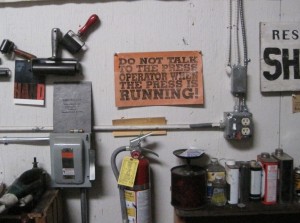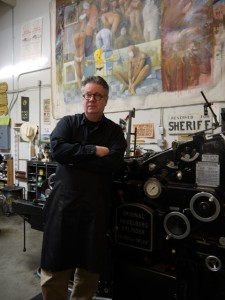by Candie Sanderson This summer, needing a break from the dry 90+ heat of the Missoula summer, I traveled to California and resumed my old job in the East Bay: selling original vintage posters. This meant going back to where it all started, this American thing: California was the first state I visited, the first I lived in, the one I'd return to. There, nestled in the fog and underneath the towering bridge, is a group of generous artists and writers, die-hard revolutionaries and bon vivants, who, like poster artist David Lance Goines, stood proudly next to Mario Savio during the Free Speech Movement, and talked about surrealism when conformists were trying to bury it. Who would have thought that among them I would find a Montana native?
The first time I entered Peter Koch's sanctuary – a very private printing shop on the Fourth Street corridor in Berkeley – I knew nothing yet about Missoula's infamous cowboy surrealist. I was intimidated: entering Peter Koch's shop is stepping into a world of fine craftsmanship and bold artistry, with a guide who is nothing short of a legend. Peter Koch has worked for libraries, museums, universities. He has published and printed books of philosophy, poetry and literature – all the way to the Ancient Greek. His work, sophisticated, difficult, has been exhibited in places such as the New York and the San Francisco Public Libraries. On the walls of his shop, I saw beautiful poems in intricate types, brown sheets of handmade paper meant to imitate leather, black and white pictures of buffaloes and Native Americans printed on a paper so thin and fine the images seemed to be holding ghosts. These were no other than the pages of Missoula writer and UM faculty member Debra Earling's Lost Journals of Sacajewea. Little did I know that I would be sitting in one of her classes a year later.
Peter Koch embodies a dandier Missoula: one that was versed in counterculture, full of literary mavericks, modern-day pioneers, and cowboy surrealists. When Koch was still in Missoula, attacking those trying to ape Richard Hugo and falling into what he called “miserablism,” he founded the Montana Gothic: A Journal of Poetry, Literature and Graphics, a literary publication meant to argue with the romanticized vision of the West that was popular at the time. Between 1974 and 1977, six issues appeared, featuring artists like Jay Rummel and writers like Tess Gallagher.
Last month, during my California trip, I paid a visit to Koch's now familiar sanctuary. I sat down with him, this time as a friend, to discuss Missoula and the writing happening in its mountains. He handed me another one of his exceptional books: The Complete Montana Gothic, an anthology which contains all six issues of the ephemeral publication, along with new essays by Rick Newby, Edwin Dobb, David E. Thomas, and Koch himself. The release party, which was held at the Missoula Art Museum, brought back to the stage a West that is too seldom talked about. And I was lucky enough to attend.
For more about Peter Koch, check out The Independent's article .



